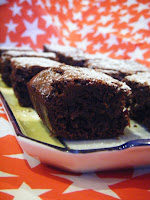I wanted to create a black forest cupcake, instead of the usual Black Forest Cake. A Black Forest Cake usually consists of a chocolate cake filled with whipped cream and cherries and the sides of the cake are cover in flaked almonds. I wanted to make this into a cupcake by spooning the middle out of a cupcake and filling it with cherry jam. Then to pipe whipped cream on top, and sprinkle with toasted flaked almonds (as this gives the almonds more colour against the white whipped cream) and finally to place a cherry on top.
I used one of my favourite chocolate cake recipes from Peggy Porschen's cookbook. I have used this recipe many times before and therefore know that it works. When I made these cupcakes I didn't read the recipe correctly, and therefore added some of the ingredients in the wrong order; which had a big effect on the outcome of the cupcakes. I also added a 50g too much sugar; as I was lazy and poured the sugar straight into the pan of milk and a bit too much came out. The cupcakes didn't rise but spread out over the cupcake case. Also some of the cupcakes stuck to the pan and didn't gel together but crumbled when turned out. If a cookie has too much sugar in it then it will spread out on the baking tray and not rise; which is exactly what happened to me!
To save the cakes I decided to layer them in a glass. The bottom of the glass was filled with a layer of chocolate cake and then some cherry jam. This was then covered with more chocolate cake. The top was finished with whipped cream, a sprinkle of flaked almonds and a cherry.
Chocolate Cupcakes
Makes 24 mini cupcakes
Ingredients:
FOR THE CAKE:
75g dark chocolate
100ml milk
225g light brown sugar
75g salted butter, softened
2 eggs
150g plain flour
2 teaspoons cocoa powder
1/2 teaspoon baking powder
1/2 bicarbonate of soda
FOR THE TOP:
100g cherry conserve / jam
300ml double cream
2 tablespoons castor sugar
24 fresh cherries
50g toasted flaked almonds
Method:
- Grease 24 cupcakes holes. Preheat the oven to C160.
- Put the chocolate, milk and half of the sugar into a saucepan and bring to the boil. Take off the heat.
- Put the butter and other half of the sugar into the bowl of an electric mixer. Beat for 3 - 4 minutes until the sugar has dissolved and the mixture is light and fluffy. Add the eggs one at a time, mixing well after each addition.
- Add the flour, cocoa, baking powder and bicarbonate of soda into the egg mixture and whisk at a low speed until just combined. Pour in the mixture from the saucepan slowly into the other mixture whilst whisking at a low speed.
- Once combined spoon the mixture into the cupcake cases, filling the cases to about two thirds full.
- Cook for 13 - 18 minutes or until golden at the edges. Cool.
- Pour the double cream and sugar into the bowl and whisk until soft peaks are formed.
- Using a teaspoon spoon out part of the middle of a cupcake and fill it with a small blob of cherry jam. Next pipe whipped cream on top, and then sprinkle with toasted flaked almonds and finally place a cherry on top.
 So after the inspiring visit to the Hummingbird bakery, I decided to create my own Christmas cupcakes.
So after the inspiring visit to the Hummingbird bakery, I decided to create my own Christmas cupcakes. 








































